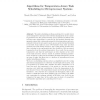AAIM
2008
Springer
14 years 5 months ago
2008
Springer
We consider a generalization of the shortest-path problem: given an alphabet , a graph G whose edges are weighted and -labeled, and a regular language L , the L-constrained shortes...
AAIM
2008
Springer
14 years 5 months ago
2008
Springer
We give a randomized protocol for the classic cake cutting problem that guarantees approximate proportional fairness, and with high probability uses a linear number of cuts.
AAIM
2008
Springer
14 years 5 months ago
2008
Springer
Many recommendation systems suggest items to users by utilizing the techniques of collaborative filtering (CF) based on historical records of items that the users have viewed, purc...
AAIM
2008
Springer
14 years 10 months ago
2008
Springer
We present a polynomial-time approximation algorithm for legally coloring as many edges of a given simple graph as possible using two colors. It achieves an approximation ratio of ...
AAIM
2008
Springer
14 years 10 months ago
2008
Springer
AAIM
2008
Springer
14 years 10 months ago
2008
Springer
AAIM
2008
Springer
14 years 10 months ago
2008
Springer
For digraphs D and H, a mapping f : V (D)→V (H) is a homomorphism of D to H if uv ∈ A(D) implies f(u)f(v) ∈ A(H). If, moreover, each vertex u ∈ V (D) is associated with co...
AAIM
2008
Springer
14 years 10 months ago
2008
Springer
A promising approach to compare two graph clusterings is based on using measurements for calculating the distance between them. Existing measures either use the structure of cluste...
AAIM
2008
Springer
14 years 10 months ago
2008
Springer
We study the combinatorial properties of optimal refueling policies, which specify the transportation paths and the refueling operations along the paths to minimize the total trans...
AAIM
2008
Springer
14 years 10 months ago
2008
Springer
This paper deals with the maximum triangle packing problem. For this problem, Hassin and Rubinstein gave a randomized polynomial-time approximation algorithm that achieves an expe...




